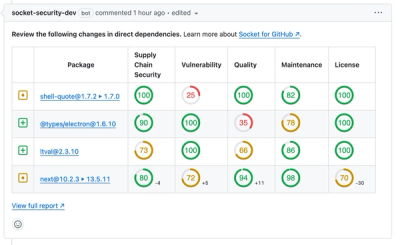
Security Fundamentals
Turtles, Clams, and Cyber Threat Actors: Shell Usage
The Socket Threat Research Team uncovers how threat actors weaponize shell techniques across npm, PyPI, and Go ecosystems to maintain persistence and exfiltrate data.
compose-components
Advanced tools
Combine multiple React components (like providers) while maintaining fully typed props support. Up to **10 times faster** than using `cloneElement`.
Combine multiple React components (like providers) while maintaining fully typed props support. Up to 10 times faster than using cloneElement.
pnpm install compose-components
import { ComposeComponents, composeComponents } from "compose-components";
const App = () => (
<ComposeComponents
renderComponents={composeComponents(
[PaletteProvider, { mode: "light" }],
[LayoutProvider, { layout: "default" }],
[TypographyProvider, { font: "sans" }],
)}
>
<div>App</div>
</ComposeComponents>
);
declare function PaletteProvider({ children }: React.PropsWithChildren<{ mode: "light" | "dark" }>): React.ReactNode;
declare function LayoutProvider({ children }: React.PropsWithChildren<{ layout: "default" | "full" }>): React.ReactNode;
declare function TypographyProvider({ children }: React.PropsWithChildren<{ font: "sans" | "serif" }>): React.ReactNode;
Since cloneElement is not used, this approach is nearly 10x faster than the version that uses cloneElement.
compose-components [ main][+][📦 v0.0.0][ v22.6.0]
❯ pnpm benchmark
> compose-components@0.0.0 benchmark
> pnpm -F "./benchmark" run start
> benchmark@0.0.0 start compose-components/benchmark
> tsx ./main.tsx
┌─────────┬────────────────────────┬─────────────┬───────────────────┬──────────┬─────────┐
│ (index) │ Task Name │ ops/sec │ Average Time (ns) │ Margin │ Samples │
├─────────┼────────────────────────┼─────────────┼───────────────────┼──────────┼─────────┤
│ 0 │ 'with cloneElement' │ '222,705' │ 4490.229389930139 │ '±0.25%' │ 66812 │
│ 1 │ 'without cloneElement' │ '2,049,821' │ 487.8472469985147 │ '±0.35%' │ 614947 │
└─────────┴────────────────────────┴─────────────┴───────────────────┴──────────┴─────────┘
FAQs
Combine multiple React components (like providers) while maintaining fully typed props support. Up to **10 times faster** than using `cloneElement`.
The npm package compose-components receives a total of 8 weekly downloads. As such, compose-components popularity was classified as not popular.
We found that compose-components demonstrated a healthy version release cadence and project activity because the last version was released less than a year ago. It has 1 open source maintainer collaborating on the project.
Did you know?

Socket for GitHub automatically highlights issues in each pull request and monitors the health of all your open source dependencies. Discover the contents of your packages and block harmful activity before you install or update your dependencies.

Security Fundamentals
The Socket Threat Research Team uncovers how threat actors weaponize shell techniques across npm, PyPI, and Go ecosystems to maintain persistence and exfiltrate data.

Security News
At VulnCon 2025, NIST scrapped its NVD consortium plans, admitted it can't keep up with CVEs, and outlined automation efforts amid a mounting backlog.

Product
We redesigned our GitHub PR comments to deliver clear, actionable security insights without adding noise to your workflow.